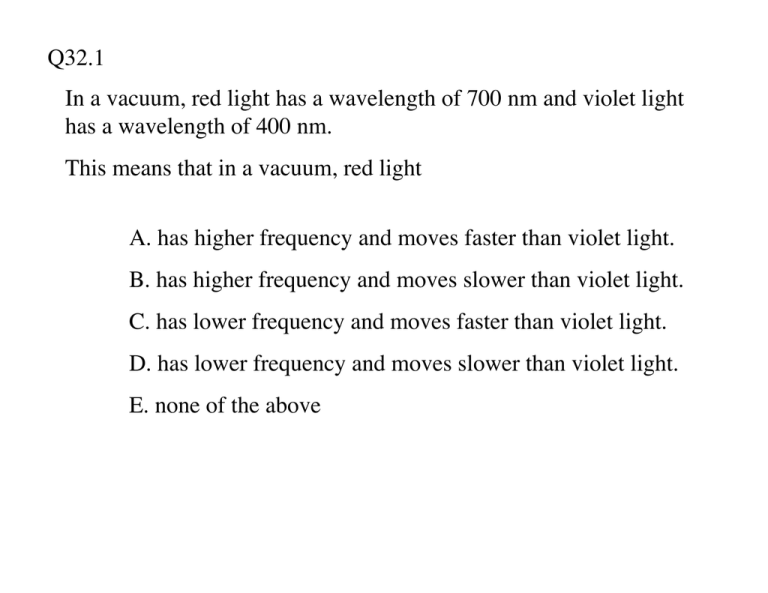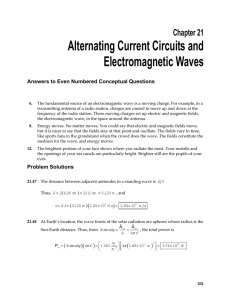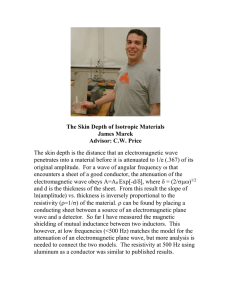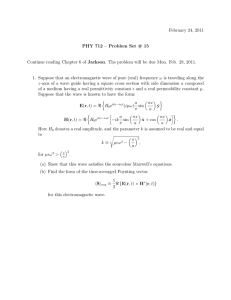In a vacuum, red light has a wavelength of 700 nm and violet light
advertisement

Q32.1 In a vacuum, red light has a wavelength of 700 nm and violet light has a wavelength of 400 nm. This means that in a vacuum, red light A. has higher frequency and moves faster than violet light. B. has higher frequency and moves slower than violet light. C. has lower frequency and moves faster than violet light. D. has lower frequency and moves slower than violet light. E. none of the above A32.1 In a vacuum, red light has a wavelength of 700 nm and violet light has a wavelength of 400 nm. This means that in a vacuum, red light A. has higher frequency and moves faster than violet light. B. has higher frequency and moves slower than violet light. C. has lower frequency and moves faster than violet light. D. has lower frequency and moves slower than violet light. E. none of the above Q32.2 At a certain point in space, the electric and magnetic fields of an electromagnetic wave at a certain instant are given by r E = iˆ (6 103 V/m ) r B = kˆ (2 10 5 T ) This wave is propagating in the A. positive x-direction. B. negative x-direction. C. positive y-direction. D. negative y-direction. E. none of the above A32.2 At a certain point in space, the electric and magnetic fields of an electromagnetic wave at a certain instant are given by r E = iˆ (6 103 V/m ) r B = kˆ (2 10 5 T ) This wave is propagating in the A. positive x-direction. B. negative x-direction. C. positive y-direction. D. negative y-direction. E. none of the above Q32.3 A sinusoidal electromagnetic wave in a vacuum is propagating in the positive z-direction. At a certain point in the wave at a certain instant in time, the electric field points in the negative x-direction. At the same point and at the same instant, the magnetic field points in the A. positive y-direction. B. negative y-direction. C. positive z-direction. D. negative z-direction. E. none of the above A32.3 A sinusoidal electromagnetic wave in a vacuum is propagating in the positive z-direction. At a certain point in the wave at a certain instant in time, the electric field points in the negative x-direction. At the same point and at the same instant, the magnetic field points in the A. positive y-direction. B. negative y-direction. C. positive z-direction. D. negative z-direction. E. none of the above Q32.4 In a sinusoidal electromagnetic wave in a vacuum, the electric field has only an x-component. This component is given by Ex = Emax cos (ky + t) This wave propagates in the A. positive z-direction. B. negative z-direction. C. positive y-direction. D. negative y-direction. E. none of the above A32.4 In a sinusoidal electromagnetic wave in a vacuum, the electric field has only an x-component. This component is given by Ex = Emax cos (ky + t) This wave propagates in the A. positive z-direction. B. negative z-direction. C. positive y-direction. D. negative y-direction. E. none of the above Q32.5 In a sinusoidal electromagnetic wave in a vacuum, the electric field has only an x-component. This component is given by Ex = Emax cos (ky + t) The magnetic field of this wave A. has only an x-component. B. has only a y-component. C. has only a z-component. D. not enough information given to decide A32.5 In a sinusoidal electromagnetic wave in a vacuum, the electric field has only an x-component. This component is given by Ex = Emax cos (ky + t) The magnetic field of this wave A. has only an x-component. B. has only a y-component. C. has only a z-component. D. not enough information given to decide Q32.6 In a sinusoidal electromagnetic wave in a vacuum, the magnetic energy density A. is the same at all points in the wave. B. is maximum where the electric field has its greatest value. C. is maximum where the electric field is zero. D. none of the above A32.6 In a sinusoidal electromagnetic wave in a vacuum, the magnetic energy density A. is the same at all points in the wave. B. is maximum where the electric field has its greatest value. C. is maximum where the electric field is zero. D. none of the above Q32.7 The drawing shows a sinusoidal electromagnetic wave in a vacuum at one instant of time at points between x = 0 and x = . At this instant, at which values of x does the instantaneous Poynting vector have its maximum magnitude? A. x = 0 and x = only B. x = /4 and x = 3/4 only C. x = /2 only D. x = 0, x = /2, and x = A32.7 The drawing shows a sinusoidal electromagnetic wave in a vacuum at one instant of time at points between x = 0 and x = . At this instant, at which values of x does the instantaneous Poynting vector have its maximum magnitude? A. x = 0 and x = only B. x = /4 and x = 3/4 only C. x = /2 only D. x = 0, x = /2, and x = Q32.8 The drawing shows a sinusoidal electromagnetic standing wave. The average Poynting vector in this wave A. points along the x-axis. B. points along the y-axis. C. points along the z-axis. D. is zero. E. none of the above A32.8 The drawing shows a sinusoidal electromagnetic standing wave. The average Poynting vector in this wave A. points along the x-axis. B. points along the y-axis. C. points along the z-axis. D. is zero. E. none of the above





